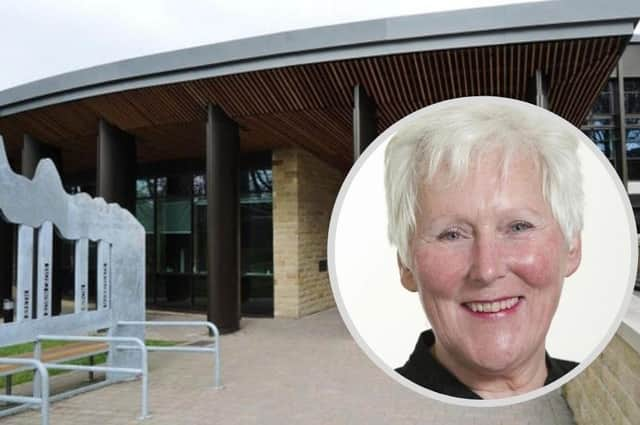Cutting councillor numbers in half a 'step back for local representation', says Harrogate's Lib Dems


In May's elections 21 councillors for the district will be chosen to serve on the new North Yorkshire Council - far fewer than the 42 currently on Harrogate Borough Council and North Yorkshire County Council which will both be scrapped in April 2023.
The arrangements recently announced as part of draft legislation have been criticised by Harrogate's Liberal Democrats who have raised concerns that residents’ voices will be diluted.
Advertisement
Hide AdAdvertisement
Hide AdCouncillor Pat Marsh, leader of the opposition party on Harrogate Borough Council, said: "We see the significant reduction in councillors as a step back in terms of local representation on the new North Yorkshire Council.
"This change is being forced on us and Liberal Democrats were not in support of the proposed warding arrangements, and in fact submitted an alternative proposal to central government which they did not support."
Overall, the new North Yorkshire Council will have a total of 90 councillor seats - 18 more than the existing county council.
Advertisement
Hide AdAdvertisement
Hide AdIt has been argued that the arrangements will make things simpler for residents who under the current two-tier system can have two different councillors, each with different responsibilities over services from bin collections to highways.
The new North Yorkshire Council will be made of 89 new divisions and councillors will serve for one year as county councillors before transferring to the new authority in April 2023.
After this, the next elections will then take place in 2027.
The new divisions have been set out by government in a draft Structural Changes Order which MPs are expected to approve by March.
Advertisement
Hide AdAdvertisement
Hide AdHarrogate Borough Council previously chose not to submit its own warding proposals last September when its Conservative leader councillor Richard Cooper said he would be "content" with what has now been proposed.
But councillor Marsh said she believed the areas that councillors will represent will be "too large". She also said although her party had opposed reorganisation, it was now pushing for greater powers to be handed to area committees and parish and town councils.
This includes powers being granted to a potential Harrogate Town Council - an idea which the Conservatives have also supported.
Councillor Marsh said: "The Liberal Democrats have not been in support of this massive change in local government representation, particularly in the middle of a global pandemic.
Advertisement
Hide AdAdvertisement
Hide Ad"As the champions of localism and the moving of decision making closer to residents, we do support the increase in powers for the new area committees and the potential for town and parish councils to be able to deliver services and manage local assets if they so choose."
Here are the new divisions and current wards for the Harrogate district:
New: Bilton Grange and New Park
Current: Harrogate Bilton Grange, Harrogate New Park
Bilton and Nidd Gorge
Harrogate Bilton Woodfield, Harrogate Old Bilton
Boroughbridge and Claro
Boroughbridge, Claro
Coppice Valley and Duchy
Harrogate Coppice Valley, Harrogate Duchy
Fairfax and Starbeck
Harrogate Fairfax, Harrogate Starbeck
Harlow and St. Georges
Harrogate Harlow, Harrogate St. Georges
High Harrogate and Kingsley
Harrogate High, Harrogate Kingsley
Killinghall, Hampsthwaite and Saltergate
Harrogate Saltergate, Killinghall and Hampsthwaite
Knaresborough East
Knaresborough Eastfield, Knaresborough Scriven Park
Knaresborough West
Knaresborough Aspin and Calcut, Knaresborough Castle
Masham and Fountains
Fountains and Ripley, Masham and Kirkby Malzeard
Oatlands and Pannal
Harrogate Oatlands, Harrogate Pannal
Ouseburn
Ouseburn and the parishes of Cattal, Hunsingore, Kirk Hammerton, Long Marston, Thornville, Wilstrop
Pateley Bridge and Nidderdale
Pateley Bridge and Nidderdale Moors and the parishes of Dacre, Darley and Menwith
Ripon Minster and Moorside
Ripon Minster, Ripon Moorside
Ripon Ure Bank and Spa
Ripon Spa, Ripon Ure Bank
Spofforth with Lower
Spofforth with Lower
Stray, Woodlands and Hookstone
Harrogate Hookstone, Harrogate Stray
Valley Gardens and Central Harrogate
Harrogate Central, Harrogate Valley Gardens
Washburn and Birstwith
Washburn and the parishes of Birstwith, Felliscliffe, and Hartwith cum Winsley
Wathvale and Bishop Monkton
Bishop Monkton and Newby Wathvale
By Jacob Webster, Local Democracy Reporter